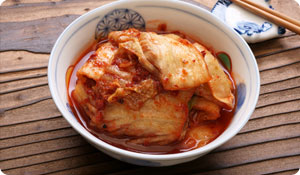
Fermented cabbage teeming with bacteria hardly sounds like a healthy food. Then why are so many people eating it?
"Fermented" may not be the first word that comes to mind when you think about or describe your favorite foods, but yeast breads, aged cheeses, apple cider, wines, beers, yogurt, dry salami, and sauerkraut are all fermented. Fermentation helps these foods taste better, makes them easier to digest and, because it is a food preservation method, also increases their shelf life. In some cases, fermentation also makes foods more nutritious and gives them medicinal qualities they wouldn't otherwise possess.
The salty, spicy, pickled vegetable dish known as kimchi is a fermented food traditionally served in Korea and now popular in other Asian countries and also in the United States. Kimchi is most often made with cabbage, but is sometimes made with other vegetables. As a result, it is rich in vitamin C, fiber, antioxidants, and other plant chemicals found only in vegetables that help maintain good health and fight the development of chronic disease.
To make kimchi, the vegetables are first salted and drained, a process that draws out their juices and helps keep the vegetable firm during further processing. Hot spices like garlic, ginger, and red chili peppers are always added, fermented fish paste or sauce is sometimes used, and the vegetables sit in the refrigerator for a couple of days to develop flavor while fermenting in their own brine.
Fermentation is the breakdown of natural sugars in a food that results in the growth of acid-forming bacteria. While kimchi is fermenting, a variety of bacteria grow in the mixture, the most important of which are lactic acid bacteria. Lactic acid bacteria are considered a type of "good bacteria" because they prevent the growth of many toxic microorganisms that could spoil food and cause food poisoning. Lactic acid fermentation also enhances the digestion of foods and the absorption of nutrients by destroying some of the naturally occurring chemicals in foods that can interfere with these processes.
Kimchi is as well known for its versatility as it is for its health-promoting qualities. It is used as an appetizer, a side dish, a condiment, and a seasoning. You'll find kimchi in dishes as diverse as scrambled eggs, fried or plain rice, noodle soup, dumplings, and beef stew. In some Korean families, kimchi is served at breakfast, lunch, and dinner.
Although the flavor of kimchi varies with the maker, it has a distinctive—and some say addictive—salty, spicy, sweet, and sour base, and the lactic acid fermentation process causes carbonation of the brine. In Korean families, kimchi is usually homemade, stored in the refrigerator, and replenished on a regular basis. Commercially-prepared and bottled kimchi is available in specialty supermarkets. But, as with most food products, fresh is almost always better, because processing alters the flavor of kimchi, and pasteurization kills some of the nutrients and active lactobacilli, or beneficial bacteria.
Sources:
Brooks, D. "Role of Microorganisms in Kimchi" University of Nebraska-Lincoln; 23 Jun 2011 Web 4 Aug 2011
http://dwb.unl.edu/Teacher/NSF/C11/C11Links/kimchi.kfri.re.kr/2-1-5.htm
Life in Korea: Kimch'i
http://www.lifeinkorea.com/culture/kimchi/kimchi.cfm





